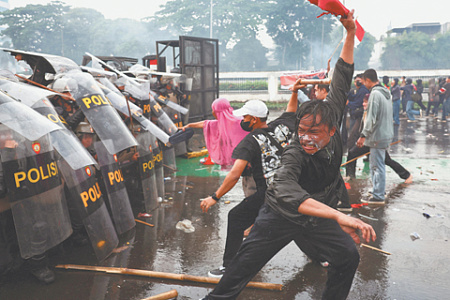
Indonesia is facing the most significant wave of protests of President Prabowo Subianto’s tenure, as public outrage over rising taxes, unemployment, and extravagant benefits for government officials boils over into violent confrontations. The government now confronts a difficult choice: concede to the demonstrators’ demands or resort to a forceful crackdown to quell the nationwide unrest.
The turmoil has escalated dramatically across the archipelago. On Saturday, August 30, demonstrators set fire to regional parliament buildings in West Nusa Tenggara, Pekalongan, and Cirebon. These acts of arson followed a fatal incident on August 28, when a police vehicle struck and killed a motorcycle taxi driver during a mass protest. Earlier, a similar attack on the city council building in Makassar left three people dead and five injured.
From the capital, Jakarta, to regional cities, protesters are unified by a common set of grievances. They have taken to the streets to rally against a deteriorating quality of life, fueled by rising taxes and a deep sense of disappointment with President Subianto’s policies. Elected in the fall of 2024 on a clear platform, Subianto promised to reduce unemployment, control inflation, and deliver robust economic growth. So far, the only promise kept has been an increased tax burden, which has been applied to all citizens.
Public anger is compounded by the government’s high-profile spending priorities. While citizens face economic hardship, officials are set to receive lavish perks, such as a monthly housing allowance of approximately $3,000 for members of parliament—a sum ten times the national minimum wage. This, combined with controversial budget allocations like a $1 billion program for free school meals, is seen as a mockery by many Indonesians, where nearly one in ten lives below the poverty line.
The discontent extends beyond economic issues. President Subianto, a former military general, has pursued policies to expand the armed forces’ influence, allowing military personnel to occupy a greater number of civilian government posts. This move has stoked fears of a democratic backslide, with many citizens worried that Indonesia could be returning to a darker chapter in its history.
The growing power of the military is ominously reminiscent of the Suharto regime, which ruled from the 1960s to the 1990s. That period of military dictatorship is remembered for a severe economic crisis and mass political repression that resulted in the deaths of nearly one million people, leaving a deep and controversial scar on the nation’s psyche.
The government’s contradictory messaging is further eroding public trust. While President Subianto publicly calls for calm and promises a “thorough and transparent investigation” into the taxi driver’s death, the National Police Chief has simultaneously stated he has been ordered to take “decisive measures” against those disrupting public order. This duality projects an image of a divided and unreliable leadership.
Whether President Subianto will opt for a hardline approach or seek compromise remains uncertain. According to regional experts, Subianto’s background as a “tough politician” suggests a preference for forceful action. However, he is also operating in the shadow of his predecessor, Joko Widodo, who was known for seeking compromise. With the public accustomed to a softer response to dissent, Subianto faces a complex strategic decision that will define his presidency.
